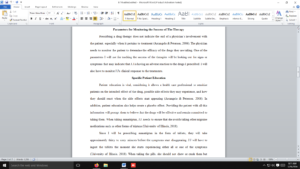Pharmacotherapeutics for Advanced Practice
J.J., age 24, presents to your practice for the first time. She reports constant headaches. She smokes a pack of cigarettes a day but is in good health otherwise. She states that the headaches usually occur in the morning and last a few hours. The pain, localized to an area near her right temple, has a throbbing quality. The headache often results in nausea and vomiting and sensitivity to bright lights. She has tried to treat the headaches with acetaminophen, ibuprofen, and naproxen unsuccessfully. The headaches are causing her to miss work, and she is afraid she will lose her job. Find attached the instructions.
recommended Textbook; “pharmacotherapeutics for advanced practice” published by Walter Kluwer
The information you need is in unit 9
Answer previewPatient education is vital, considering it allows a health care professional to sensitize patients on the intended effect of the drug, possible side effects they may experience, and how they should react when the side effects start appearing (Arcangelo & Peterson, 2006). In addition, patient education also helps create a placebo effect. Providing the patient with all this information will prompt them to believe that the drugs will be effective and remain committed to taking them. When taking sumatriptan, J.J. needs to ensure that she avoids taking other migraine medications such as other forms of triptans (University of Illinois, 2018).
[1356 Words]
Pharmacotherapeutics for Advanced Practice


